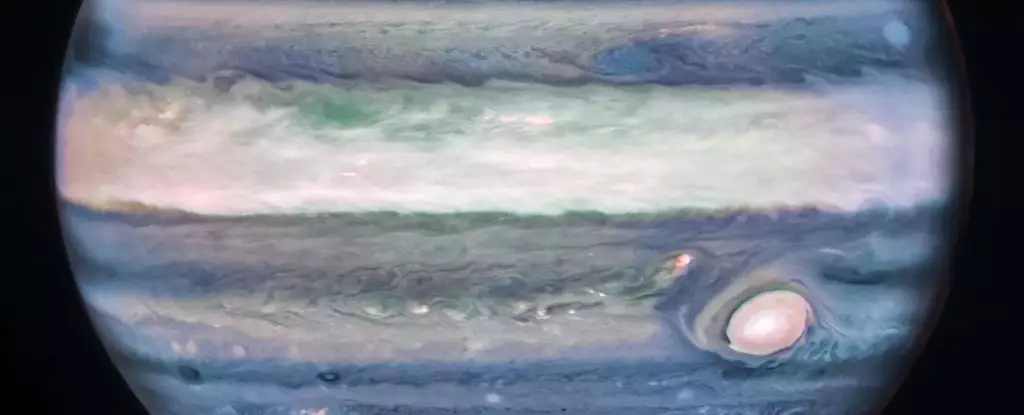Jupiter, the second-largest object in the entire Solar System, continues to astound scientists with its mysterious and dynamic atmosphere. Despite numerous probes sent to study the giant planet, researchers are continuously uncovering never-before-seen features in its tempestuous clouds. In a surprising turn of events, astronomers using the powerful infrared James Webb Space Telescope (JWST) have recently discovered a high-speed jetstream racing around Jupiter’s equator, located above its cloud layer. This groundbreaking revelation could provide valuable insights into the intricate and peculiar weather patterns of Jupiter, which have remained poorly understood until now.
Jupiter’s atmosphere, with its alternating bands of light and dark clouds called zones and belts, respectively, has always been a source of fascination. These atmospheric features not only swirl around the planet at various altitudes but also move in opposite directions. Despite our extensive knowledge of Jupiter’s weather system, the reasons behind these intriguing patterns remain elusive. By observing Jupiter in different wavelengths, astronomers unveil details that are not visible in optical ranges. For example, the most powerful aurorae in the entire Solar System, found on Jupiter, emit ultraviolet light, which is invisible to the naked eye. The James Webb Space Telescope, equipped with state-of-the-art infrared technology, allows us to observe Jupiter in near-infrared wavelengths, offering a unique perspective on the giant planet. Earlier this year, the telescope captured detailed images that resemble photo negatives, revealing the upper levels of Jupiter’s atmosphere situated between 25 and 50 kilometers (15 to 30 miles) above its cloud tops.
An in-depth analysis of these near-infrared images brought an unexpected finding to light. Scientists from the University of the Basque Country in Spain, led by astronomer Ricardo Hueso, identified a high-speed jetstream within Jupiter’s equatorial region. Previously only observed as a vague haze, this powerful stream is now visible as a distinct feature. The jetstream, located approximately 40 kilometers (25 miles) above the cloud tops, races around Jupiter at an astonishing speed of 515 kilometers per hour (320 miles per hour).
This revelatory discovery holds immense potential for enhancing our understanding of Jupiter’s weather dynamics. The researchers compared the data from Hubble observations of the lower cloud levels, which move at half the speed of the newly discovered jetstream. By examining small-scale storm features that appeared and disappeared between rotations and considering the varying wind speeds, the astronomers identified vertical shears and realized that the jetstream could be part of a broader weather pattern observable on Jupiter. Furthermore, this finding provides the most accurate measurement to date of how Jupiter’s equatorial wind speed changes with altitude.
Unlocking Jupiter’s Weather Mystery
According to planetary scientist Leigh Fletcher from the University of Leicester in the UK, “Jupiter has a complicated but repeatable pattern of winds and temperatures in its equatorial stratosphere, high above the winds in the clouds and hazes measured at these wavelengths.” The intricate relationships between wind patterns, temperatures, and atmospheric phenomena within Jupiter’s equatorial stratosphere are finally beginning to emerge, thanks to the surprising discovery of the high-speed equatorial jetstream. This newfound knowledge will pave the way for further research and in-depth investigations into the mysteries of Jupiter’s atmospheric dynamics.
The recent revelation of a high-speed jetstream roaring around Jupiter’s equator, discovered using the James Webb Space Telescope, has greatly advanced our understanding of the enigmatic giant planet. By revealing never-before-seen features in Jupiter’s atmosphere, this groundbreaking discovery offers valuable insights into its weather patterns and atmospheric dynamics. With this new knowledge, scientists are poised to unlock the secrets hidden within Jupiter’s tumultuous clouds, bringing us closer to unraveling the mysteries of our solar system’s most awe-inspiring planets.


Leave a Reply